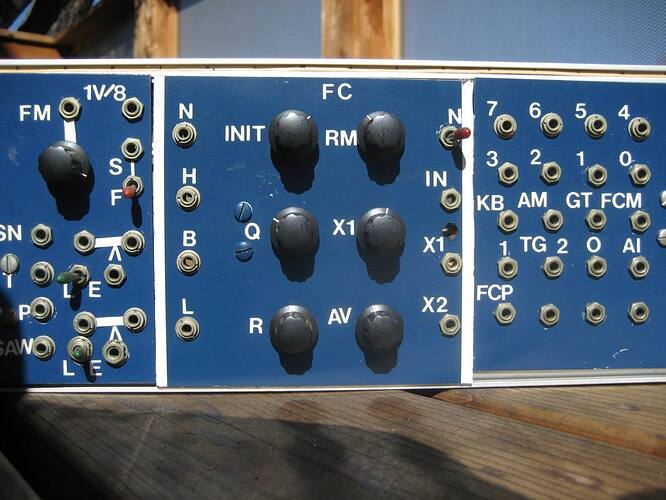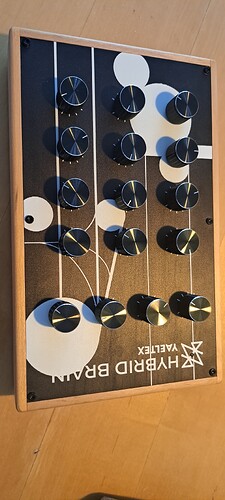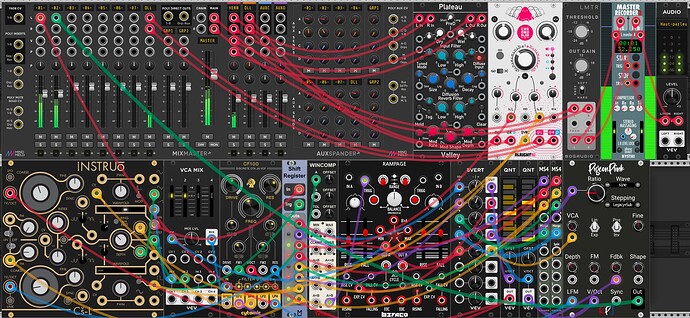I experimented with your new MIX4 modules in the patch and the first results are very promising!! The FM modulation/Rungling is much more “stable” in the extreme registers with the x2 oversampling I will post an updated patch when I am home. But I wanted to share my excitement over this improvement already! Great job @DaveVenom !!
I read on one of the forums of Blippoo users that the chicken head knobs actually influences the way of playing the instrument a lot: With round knobs you tend to dial in slow changes; with the sensitive chicken heads you tend to “swap” them quicker by just quickly tapping them, resulting in more abrupt or versatile changes.
Here is the refined patchfile BLIPPOO BOX V2_ROB HORDIJK.vcv (17.9 KB)
and a quick testdrive
hope you like it!
I did some more experiments, and now I see what you mean about the Slime Child LP4 vs the Vult Lateralus. The LP4 does an excellent at creating really nice pings over the entire frequency range, without ever self oscillating. In contrast, setting the Lateralus to ping well at low frequencies causes it to self oscillate at high frequencies.
I created my own version(s) of the Blippoo Box, and so far the best free filter I have found is the Vult Unstabile, just like with the Benjolin. I don’t think the BP feedback works as effectively, but it does ping over the entire range beautifully without self oscillation.
Here are two versions of the Blippoo Box - the first is my attempt to recreate the original design, and the second adds an extensive patch bay along with a few extra knobs so that you can experiment with different combinations of signals that the Blippoo Box is able to generate. Thanks Koen for all the info about Rob’s Hordijk’s many variation. I did some more searching, and it looks like he had more than just the three variations. Much like your patch, my goal was to allow the user to explore as many combinations as possible.
These are the first patches I am releasing where I feature my new Venom MIX 4 module.
Blippoo Box.vcv (5.3 KB)
Blippoo Box Extended.vcv (8.6 KB)
And here is a patch and video where I combine the extended version of the Blippoo Box with my newest version of the Benjolin (I’m calling it a Benjolippoolin). The patch demonstrates some really nice autogenerative possibilities. I may be playing with this combination for a while.
Autogenerative Benjolippoolin.vcv (12.4 KB)
And lastly here is the Benjolin on its own. I’ve included notes, and maximized usage of the Venom plugin, and also rearranged and labeled patch sections logically so it is easier to trace how it is constructed.
Benjolin V5.vcv (7.1 KB)
Most of my filters don’t self oscillate, but both F2 and Stairway are carefully tuned to have consistent Q across the audible frequency range. Without that very strange things would happen at high frequencies.
Yes - I tried the F2. It definitely worked, but the ping was not as satisfying. It was interesting, because the F2 Par - is effectively a self contained Twin Peaks in one module. But instead of having independent direct control over the two frequencies, F2 has one cutoff control, and the R Spread controls the distance between the resonant peaks.
Were you aware of the similarities with Rob Hordijk’s Twin Peaks when you created F2?
I need to try out the Stairway. I think the module width discouraged me from trying it - I tend to favor compact modules. But I will run some experiments now.
@Squinky Oh my! The Stairway works really well. Its inability to self oscillate makes it ideal for use in a Blippoo Box. I’m getting some gorgeous tones by using 2P LP mode and patching Left out to Right in. I think that effectively makes the Right out a 4P LP, and I use the Left 2P output for FM feedback. In theory I think this may be more similar to Rob Hordijk’s actual Twin Peaks. The Clean mode especially sounds good.
I save considerable space by turning stereo polyphony on and using two Grande Merge Split modules, so I only need one Stairway to get both filters (peaks). One Merge Split is used for the input and the 4P output. The other Merge Split is used for the cutoff CV and the 2P output. Both peaks get the same Q modulation, so monophonic Q CV is perfectly fine.
I probably won’t use Stariway in a Benjolin because it cannot simultaneously output LP, HP, and BP. But I may switch to using Stairway in the Blippoo Box going forward.
haha - no I had never heard of a twin peaks before. I was actually trying to make a digital version of the “state variable four pole” filter from Electronotes magazine. I built one in 1978, pictured below. Unfortunately, once I purchased all the back issues and tried to do it digitally, it didn’t work well. It was called F4. No doubt my own incompetence at DSP. So I “pivoted” to F2.
Glad you like Stairway. I also don’t like huge modules. On this one of course there are a zillion controls. Some don’t do much, or aren’t very interesting. It would be “very easy” to clone it and remove the ones you don’t like. Also, it would be trivially easy to output any of those responses at the same time.
The thing I don’t like about Stairway is that it is such a CPU pig, and isn’t polyphonic.
I had a lot of fun making both those filters. While they borrow plenty from other filters, they are for sure my own creations. Stairway is pretty popular, F2 less so.
I don’t think I would remove anything. I’m finding sonic use for pretty much all the knobs. But sacrificing some of the more esoteric CV control and substituting multiple outputs might be cool. An option to route CV1 to cutoff 1, and CV2 to cutoff 2 I think would be great for realizing interesting formants. And an option to enable self oscillation would be wonderful.
I don’t find the CPU usage egregious, and it is now fully polyphonic.
Here is the Extended Blippoo Box using Stairway.
Blippoo Extended Stairway.vcv (8.8 KB)
And here is the autogenerative combined Blippoo Box and Benjolin, with Stairway in the Blippoo Box:
Autogenerative Benjolippoolin Stairway.vcv (12.2 KB)
I vacillate as to which Stairway voicing I like better. I find Transistor, Asym Clip, and Clean to be distinctly different, and all three useful within the Blippoo Box.
Hi Dave,
Just replying to this one so it stays on the same subject:
I am revisting the patch again after a break and improving some elements. One major improvement is using the Cytomic CF100 as filter cores (since this emulation is very close to the original hardware SM2040 filter chips) the result is very satisfying!
I stumble on one obstacle though when using the patch in extreme settings: the S&H control is aliasing quite a lot. I can reduce it by running the patch at 194kHz, but this is very CPU intensive -almost at the border of my M1 MacBook. I have tried different S&H modules in VCV, but none of them can cope with the high audio rate triggers that come from the Venom Wincomp. It is only audible at very high sampling rates. So not a very big deal, but nevertheless:
I would be very grateful (as I still lack the coding skills) if there could be a Venom S&H module ![]() with oversampling
with oversampling
Interesting. I know that logic gates introduce aliasing when run at audio rates. On my list of future modules is definitely a flexible logic module that has an oversampling option. But I had never considered oversampling a sample & hold. I will file that idea away and maybe in the future create something.
But I’ve already locked down what is going in my next version that is in beta. And I am pretty sure the release after that will be all about a VCO/LFO and an envelope generator. So it will likely be a while before I get around to the logic module, and possibly the S&H module.
Thanks and no rush at all!
I will be diving into a new project anyway, which is an interpretation of the Lunetta Moosack Machine
On a side note:
I do like the restriction of 12-16 knobs as a controller, making it an instrument you can practice and master without drowning having too much parameters otherwise.
I recently got a dedicated midi controller for this purpose
The quality of this one is superb and really gives me a feel of using a hardware instrument.
This is a tangent but, this thread made me want to patch something loosely inspired by the Blippoo / Benjolin.
It has a dual VCO, shift register, comparator, filter, but I wanted to add a quantizer, and a second (polyphonic) phase modulation voice (modulated by the main one). Having those 8 outputs on the shift register gives a lot of modulation possibilities, I like how it sounds alive and does not really repeats but not totally random either (well to me at least).
Here is the patch : Blipididon’t.vcv (6.1 KB)
And a quick recording of it :
I am really enjoying the patch! It has been playing for the past 1 hr plus non-stop.
Oh, Thank you ! I am glad you like it! Sometimes simple but almost alive patches bring me to stop patching and just listen for a good while…
I tried adding a few things too but nothing worked…
Also I love the way the filter introduces some unquantized sound when it self resonates, and how this makes the FM go out of tune. Like a dialog between order and chaos, nature and culture…
Just so you all know, there’s a much easier way to get such a wide frequency range without having to use multiply Pony VCOs, it also has less alaising. I was able to go from the top of the audio spectrum all the way down to a near-stopped oscillation using a Palm Loop VCO and a +/- 10V attenuverter fed into both the V/Oct and the Linear FM inputs. This creates a nice knob response that can reach both extremes while still having a large sweet spot in for “moderate” speeds as oppsoed to the exponential sweep of a traditional source fed to V/Oct. It also leaves the additional exponential FM input open for patching the modulator mix to.
Yes, there is a lot to be said for the Palm Loop VCO. Interesting idea to patch both the V/Oct input and the exponential FM. (You wrote linear FM, but I am pretty sure you wrote that reversed. The linear FM does not slow down as you go negative, but rather inverts the wave form and begins speeding up again as you go more and more negative. That is a critical feature of through 0 true FM).
I experimented with Palm Loop extensively (along with some other VCOs) when I was exploring 0 Hz carrier through 0 linear FM - It works very well for that. Palm Loop was the most CPU efficient and yet had the least amount of aliasing when modulating at high frequencies. The anti-aliasing technique used is unlike most of the other VCOs. I like Palm Loop a lot, and I think it has never gotten the attention it deserves.
The thing I find unfortunate about the Palm Loop is the saw wave is an octave higher than the triangle and square. Both octaves are available for the sine. I tried to program a derivative module that provided the same octave for all wave forms, but the anti-aliasing technique broke down in my hands when I did that.
Both the Blippoo Box and the Benjolin only require triangle and square, so I think you may be on to something. Palm Loop probably is a good choice to try.
I can’t wait to go to the studio this afternoon and hook it up to a controller ![]()
It’s a lot of fun!
Have been refining it still in the meantime and will share an updated version soon.
@Nova Thanks for the tip! I will look into the oscillator ![]()






